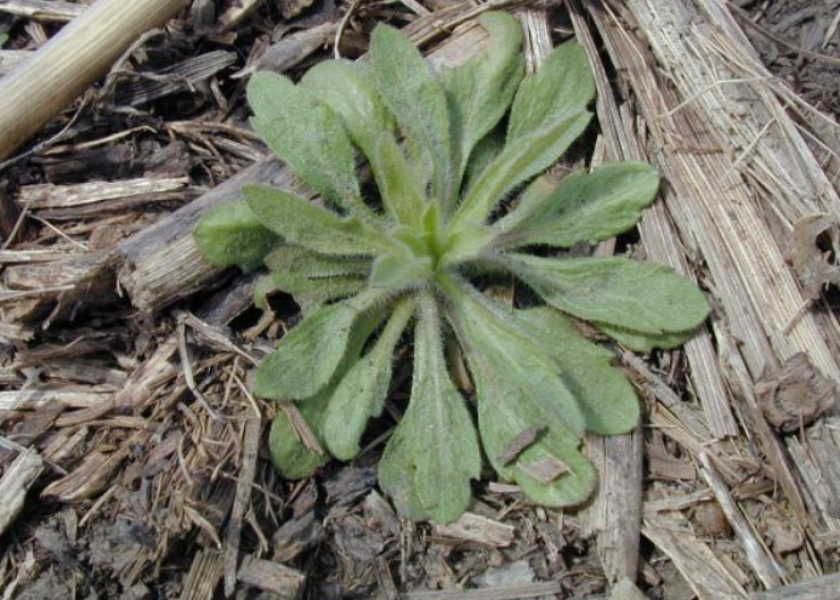2023 Looks Like a Tough Year to Control Weeds

Dry conditions crippled many farmers' weed-control efforts in corn and soybeans this past season.
If that describes your situation, agronomists say plan now to address weeds and limit their impact on your 2023 crops.
Here is a handful of their recommendations
1. Consider whether you can use a burndown application yet this fall.
Winter annuals, such as horseweed (marestail), for instance, respond well to burndown treatments, notes Meaghan Anderson, Iowa State University (ISU) field agronomist.
“Treatments made on sunny days with warm daytime (>55F) and nighttime (>40 F) temperatures will generally be more successful than those made in cooler conditions,” she says.
She adds that herbicides can still be very effective after a single frost event or even several frost events.
“Avoid herbicide applications immediately after frost and take advantage of the sunniest part of the day to spray,” she says. “(That can help make sure) plant foliage is in good condition to absorb the herbicide.”
When selecting burndown treatments, consider the spectrum of winter annual and perennial species (e.g. dandelion) in the field, advises ISU Extension. Glyphosate- and ALS-resistant horseweed populations are widespread across the state. Including 0.5 lb. ae (acid equivalent) 2,4-D LVE or 0.25 lb. ae dicamba to glyphosate will increase the consistency of horseweed control, even in fields without glyphosate resistance.
ISU says the addition of a residual herbicide in fall applications is not recommended due to the lack of consistent benefit and added expense. Residual herbicides are better left for spring herbicide applications, closer to the timeframe when most weed species are germinating.
2. Harness a high-quality adjuvant/surfactant.
This year, adjuvants and surfactants gained street cred with farmers trying to extend limited herbicide products over more acres and improve performance of active ingredients, says Mark Hockel, master agronomist for Eagle Ag Consulting, Windom, Minn.
He expects that to be the case again next season, given that manufacturers are already saying some herbicides could be in short supply.
There are three primary adjuvant categories, ranging from surfactants to oil-based adjuvants to spray utility agents. Make sure to use the type specified by your herbicide label and invest in a known (i.e. good) brand.
Hockel says to be mindful that drought can contribute to a thicker cuticle in the weed, making it potentially more difficult for the herbicide to penetrate the plant surface.
“You might want to go with a higher labelled rate of adjuvant,” he says. “If you typically use the minimum rate of an adjuvant, say 1 quart, you might go up to 1.5 or 2 quarts instead.”
Along with that, make sure you follow the herbicide label for carrier type, carrier volume and nozzle type.
3. Evaluate herbicide carryover from 2022 before implementing your control plan next spring.
Dry conditions can extend the life of a residual herbicide in soil, notes Gentry Sorenson, Iowa State University field agronomist.
“Soil moisture is one of many factors that influences degradation of a soil-applied herbicide,” he says. “When drought conditions occur, herbicides may not degrade as fast. Microbial activity may decrease with long periods of dry soil conditions.”
That could mean a problem for future crops. Hockel says that has been the case for some of his customers.
“We've had more corn herbicide carryover in beans, alfalfa and edible crops the past several years, so some farmers have shifted to other herbicides for that reason, to minimize the potential impact,” he explains.
4. Consider how to work around Mother Nature.
Consider that preemergence products commonly need ½” of rain for activation or good soil moisture if incorporated, notes Cody Creech. He tells farmers to apply pre products ahead of a rain but no more than a week to 10 days before planting.
“Some of those products are very sensitive to sunlight and start to break down the longer they sit on the soil surface,” explains Creech, University of Nebraska Extension dryland cropping systems specialist. “Even a few days of lying on the soil can impact the performance of some herbicides.”
If conditions allow, apply postemergence products after a rain, when weeds are still small but putting on new growth.
“If that’s not possible, apply post products in the morning, after weeds have had the evening period to sort of recover,” advises Sarah Lancaster, Kansas State University weed science Extension specialist.
“They're probably going to be photosynthesizing better first thing in the morning than they will after they've been exposed to 100-degree temperatures for several hours.”
5. Look at weed-control options beyond herbicide use.
The advice you got for 2022 is still in effect for next season: have a backup plan to your backup plan for herbicide products in 2023.
“Evaluate how you might use management and agronomic practices – including tillage, changes to seeding populations, planting cover crops, etc. – to supplement herbicide use,” Creech says. “Some of these could help you keep weeds in check and get crops off to a good start.”
Does Electrocuting Herbicide-Resistant Weeds Really Work? This Weed Scientist Now Has Proof
New Weed Species Confirmed in Iowa Fields a Second Time
400 Farmers Shared Their Weed Nemesis, Does Yours Match?
Volunteer Corn in Soybeans Harbors Secret Pest Problem







